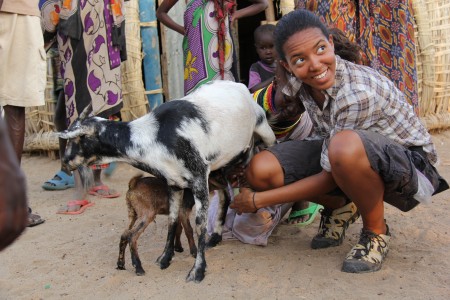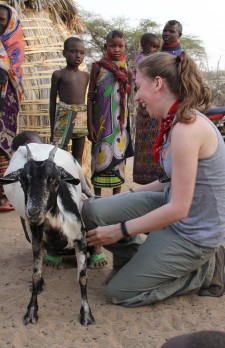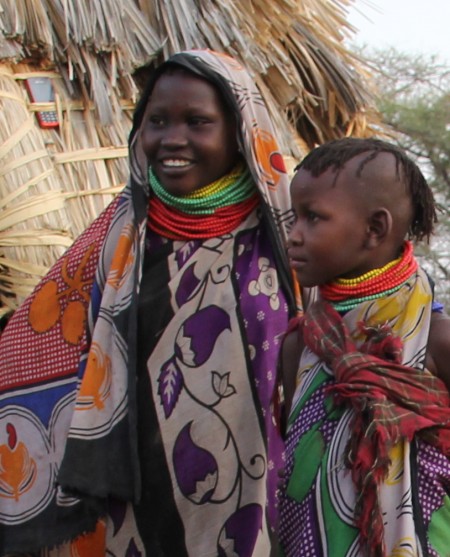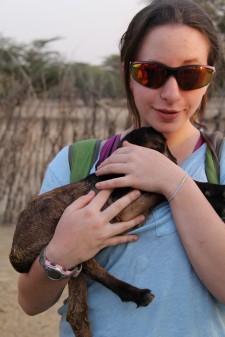The Turkana people are a traditionally pastoralist tribe, moving their livestock and their homes across the arid range in search of fodder and water for their animals. Their stock includes goats, sheep, camels, cattle, and donkeys. The number of animals and the diversity of the herd are closely linked to a family’s status in the community. The ever-grazing herds are sustenance, social standing, and bank account on the hoof.
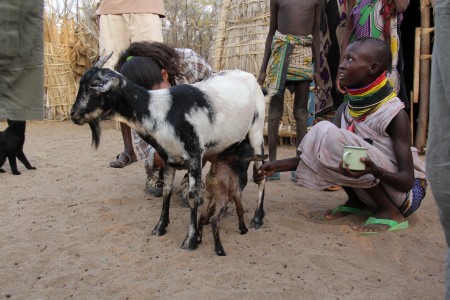
A Turkana woman who lives close to TBI with her family holds a mug of fresh milk while answering a question about the pastoralist way of life.
For many of the students, including me, it’s difficult to imagine the nomadic lifestyle that most Turkana strive for in their constant quest to provide for their animals. When I think of a life on the farm, or even on the range, there’s always a home to go back to, a stable base at the center of any romantic notions I hold about cowboys and living off the land.
It’s becoming difficult for the Turkana to imagine the mobile pastoralist life as well. As the human population increases and the herds expand, it is difficult to maintain a healthy stock of animals and to stay mobile. Even if a family manages a large herd, environmental changes such as shifting climate and weather patterns, dammed rivers that reallocate water resources, and overgrazed pastureland can decimate herds, leaving the family without stable financial resources.
Along with changing stock conditions, there are increased pressures for the Turkana to shift to a more sedentary lifestyle. Services like education, healthcare, and food aid don’t easily follow the herds, so families try to restrict their traditional movements across their territory.
Life is changing quickly for the Turkana, and the only way to understand how they will adapt is by understanding their traditional livelihoods.
Earlier this week, the field school was invited to visit a family and their livestock at a close boma, a corral of brush that functions as temporary home for wandering livestock.
After welcoming us closer to their thatched huts, the Turkana family found a milkable nanny goat. The Turkana do not often eat their animals, but rely on their stock for dairy, and they invited their guests to try a hand at milking a Turkana goat. The milker’s efforts were challenged by the nanny’s recently born kid trying to get in and nurse at the same time. The two-day-old goat provided an adorable introduction to goat herding and a bossy obstacle to dairy farming.
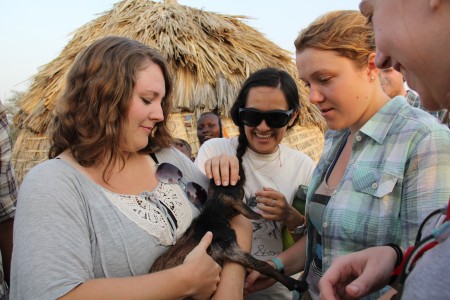
Rosie, Eve, Ingrid, and Bailey pet the two-day-old kid, temporarily distracting him from his mother.
An ailing goat was also shown to the class to illustrate the difficulty of getting access to veterinary services in the Turkana grasslands. The animal could be easily treated with modern medications, but the closest town is Lodwar, a full day’s walk from the family’s home. Such a trip is reserved for necessary supply runs and human medical emergencies.
Students were encouraged to ask questions about the family’s daily routine and relationship to their stock. The questions – such as “How often do you move?” – were translated into Swahili by Dr. Martins, which were then translated into Turkana by Francis who would listen to the response (“Not very often anymore. We want to stay close to the school for the children and the river for the goats.”) and translate the answer into Swahili which Dr. Dino brought back into English. As far as I can tell, nothing was lost through this trilingual telephone, but I don’t have a handle on Swahili, let alone Turkana.
The interview went both ways, with the Turkana women asking if any of the students keep animals and what kinds. A short discussion of chicken coops in urban settings ensued with grins all around. They followed by asking if we experienced drought at home and how it affected us. Most of the students hail from pretty temperate places that have been unaffected by drought, but that food prices had been affected by droughts in other parts of the country. This might have been a little much for our relayed conversation.

